What began as peaceful rallies over gas price hikes became widespread violence as Kazakhstanis took to the streets to demand justice and a better life
On 2 January, public rallies over a sharp rise in the price of liquefied gas began in western Kazakhstan. Just four days later, Russian troops would arrive in the country’s commercial capital, Almaty, to assist in peacekeeping operations. As the order was restored on 7 January, president Kassym-Jomart Tokayev claimed “20,000 terrorists and bandits” had attacked the city as part of an apparent coup d’etat. Some 227 people died in the clashes, according to official sources. The majority of them perished in Almaty.
These whirlwind events have left many confused as to what actually happened in Kazakhstan – and what the relationship is between the original protests and the violence.
While on 4 January, the narrative of civic protest was positive and exultant in Almaty, overnight it changed, after law enforcement used force against protesters. By 5 January, the mood appeared to be more decisive. By the end of the day, it was apocalyptic. A communications and internet shutdown at the peak of the chaos meant that few details could emerge at the time, leaving state agencies and media to guide the narrative. A more detailed account of how events emerged in Almaty, the epicentre of the violence, can therefore shed light on what protesters may have wanted. It remains unclear who was behind these episodes of violence, and who exactly participated in them.
As journalists based in the city, we were present during events on 4 and 5 January and have attempted to provide an initial, confirmed picture of events.
Disaffected community
On the evening of 4 January, a group of young people from a relatively new liberal political movement, ‘Oyan, Qazaqstan’ (‘Wake up, Kazakhstan’ in English), began to gather in Almaty near a park dedicated to Nursultan Nazarbayev, which is one of the many ‘sacred places’ devoted to the former president created by Kazakhstan’s authoritarian regime over the past 30 years. As the activists stood in heavy rain, they hoped Almaty residents would respond to their call to support protesters in the western Mangistau region. Initially, their sole ‘supporter’ was a man who came to photograph them, who was most likely from Kazakhstan’s National Security Committee. Even then, demonstrators felt that law enforcement did not intend to protect them.
After some time, a large group of men joined the activists, some of whom were known nationalists, who had previously been in conflict with the Oyan movement. That evening, it appears ideological differences lost their meaning.
Together, the two groups marched down a small street and were soon stopped by the police. In the struggle, part of the crowd managed to run away, another group was released by the police, and then the remaining people were detained, beaten or dragged along the asphalt.
Activists who managed to escape the police later joined another group of protesters on the city’s outskirts, after the Democratic Party of Kazakhstan, an unregistered opposition initiative, called a rally near the Almaty Arena sports complex.
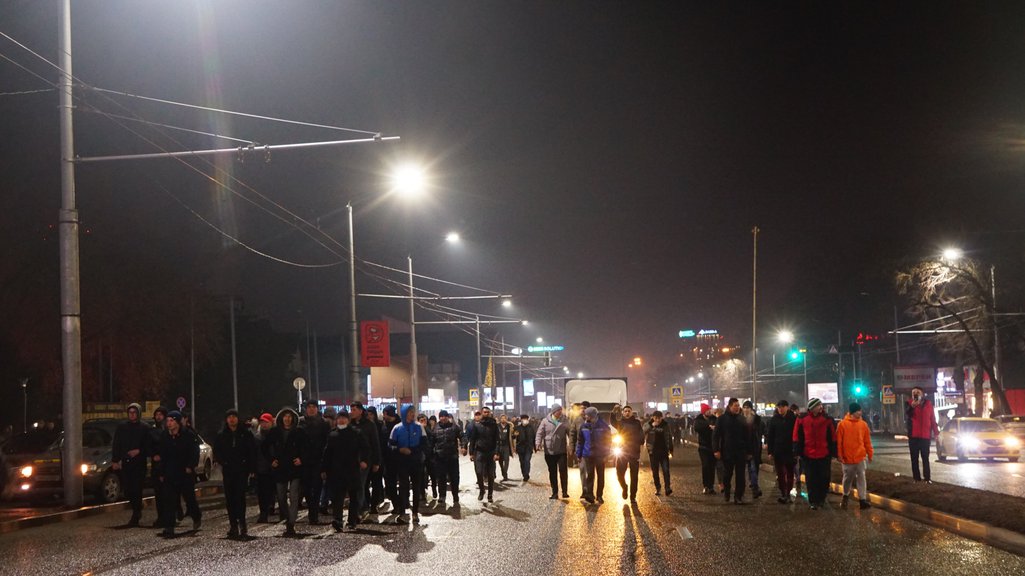
As we observed, some of the people who gathered at Almaty Arena did not belong to any political organisation or movement, and the crowd treated the leader of the Democratic Party, former journalist Zhanbolat Mamay, with caution. Some explained their scepticism over what they saw as Mamay’s possible affiliation with the Kazakhstani authorities. Mamay himself, who recently lost a defamation claim to the former mayor of Almaty over corruption allegations, has repeatedly denied these accusations.
The rally went on for several hours, before demonstrators set out on an 18-kilometre journey to Almaty’s city administration building in the centre. Their procession seemed endless – you couldn’t see its start or finish. People walked alongside traffic. Flags were hung from many cars, and demonstrators sat on the back of them. On occasion, people sang Kazakhstan’s national anthem and chanted “Alga, Kazakhstan!” (Forward, Kazakhstan!). Residents of nearby buildings greeted them from their balconies, giving out water and medical masks.
A night of clashes
Throughout the march to the city centre on 4 January, protesters spoke to one another enthusiastically. They shared their experiences and found solidarity in their main demand – not just in reducing gas prices, but in changing Kazakhstan’s entire political system.
For many years, the country’s power elite, busy enriching themselves, was able to offer citizens only lawlessness, a lack of social protection and poverty. “The Nazarbayev family steals from us all the time! We feel as if we live only to feed them. Are you also unhappy with this?” one of the protesters said.
Now, several thousand people were preparing to voice their discontent in the square next to the city administration. Among them were members of political movements, service sector workers, unemployed youth from the periphery of the city, internal migrants, and a few representatives of the urban middle class. The majority of the protesters, according to sociologist Serik Beisembayev, who studied photos and videos from the protests, were men aged between 20 and 40.
When the march reached Republic Square, the crowd filled it. The police immediately fought back with shields and batons. Security forces also began throwing stun grenades and spraying tear gas, which could be felt even a few blocks from the square.
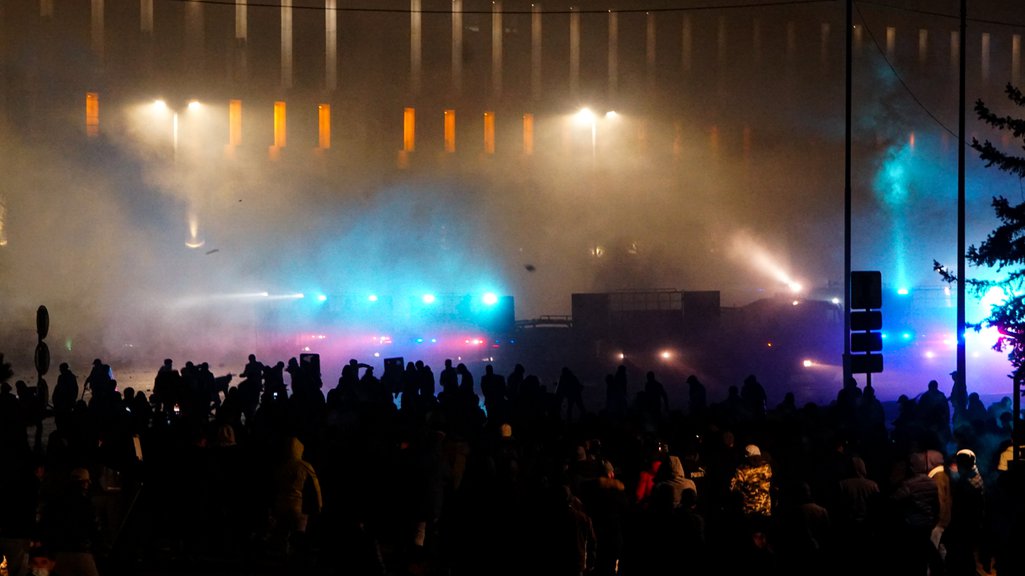
Some of the protesters began to rip out of the ground flags installed in honour of the 30th anniversary of Kazakhstan’s independence – and use them against the police. Then, sticks were used as weapons, as well as shields taken from the security forces and paving stones that had been abundantly laid out by two previous mayors in the old centre of the city.
Soon a rumour began to spread that Kazakhstani military personnel were headed towards the protesters. “Don’t run away! Why did you come?” people shouted after those who retreated. Someone gave a command, and the crowd stormed the police cordons. Others began to move towards Astana Square, where the government of the Kazakh Soviet Republic was located during the Soviet era. For several hours, they gathered forces, then began to re-engage with the police.
After midnight, a group of several young men secured a truck and used it to lead the vanguard of the protest, which was concentrated near the city administration. People climbed onto the building’s roof holding Kazakhstani flags. Almost immediately, a group of protesters swept past with placards: ‘The people are awake!’, ‘The government should resign!’, ‘The banks are sucking the people dry!’ The mood was jubilant.
Throughout the night, protesters resisted security forces. They were constantly crowded out of the square, and dispersed to different parts of the city. As the explosions of stun grenades increased, so did the force from the crowd – groups of young men began to smash police cars. They were injured, some were taken away in approaching cars. But people did not think to disperse and remained in the square.
Overnight, President Kassym-Jomart Tokayev introduced a state of emergency in Almaty, which would remain in effect until midnight on 19 January. Tokayev also ordered reductions in gas prices, and began to regulate the cost of fuels and lubricants and essential goods. At the same time, he introduced a six-month moratorium on a rise in utility tariffs. By the morning of 6 January, it was announced that Kazakhstan’s government had resigned.
The square is on fire
It appears Tokayev’s measures did not satisfy some of the protesters, and on the morning of 5 January they decided to continue the offensive. Most shops, cafes and bank branches did not open in the centre of Almaty. Public transport did not operate and taxis continued to be unavailable due to internet blockages. Republic Square was cordoned off by Kazakhstani military in armoured personnel carriers. Traces of blood were visible on the ground.
Closer to lunchtime, another large procession was formed, but on another thoroughfare, Tole bi. This march developed spontaneously, in part started by random residents of nearby houses and districts. Those who had participated in the clashes near the city administration the previous evening also joined. The protesters’ demands varied: some took to the streets because of problems with housing and unpayable loans, others to call for wage increases.
People in military or police uniforms appeared in the crowd. On social media, eyewitnesses reported rumours that individual police and military officers had gone over to the side of the protesters. They shared their equipment with other demonstrators to make them stand out less in the crowd, observers believed. We could not confirm how reliable this information is.
Some demonstrators aroused indignation and fear among other protesters by their appearance: it was easy to mistake them for adherents of radical religious movements. A bearded man with a travel bag was surrounded and asked to show the contents of his bag. “Is he not a Wahhabite [a follower of a fundamentalist movement within Sunni Islam] ? What is he carrying?” people asked. There was nothing serious in the bag, however. In total, about ten men with beards were found in the march.
5 January: seizure of Almaty city administration building. Source: Vlast.kz
On the way, a small group of demonstrators separated from the general protest and rushed to break glass in an office belonging to the ruling Nur-Otan party. Soon after, this office caught fire. Later, the participants of the march decided to block the road in order to impede the movement of law enforcement. They blocked some ambulances, which they thought could be secretly carrying security forces. When they failed to find police in them, they let them go.
Then the demonstrators began to build barricades of slabs, paving stones and other improvised means on the Tole bi. ‘This kind of thing has not happened since 1986!’ said eyewitnesses, who were surprised by the events unfolding. (That year, protesters had fiercely contested the decision of the central Soviet authorities to appoint Gennady Kolbin, an ethnic Russian who had never lived in Kazakhstan, to the head of the Kazakh Soviet Republic. Protesters were fiercely repressed as a result.)
Meanwhile, protesters exclaimed “Oyan, Kazakhstan!”, borrowing the slogan from the political movement of the same name. Different groups separated from them, which stormed various buildings, smashed windows and disabled surveillance cameras. Peaceful protesters tried to contain their fervour, but it did not always work. Tear gas was in the vicinity and a rumour spread among the crowd that it was being sprayed from the roofs of the surrounding buildings.
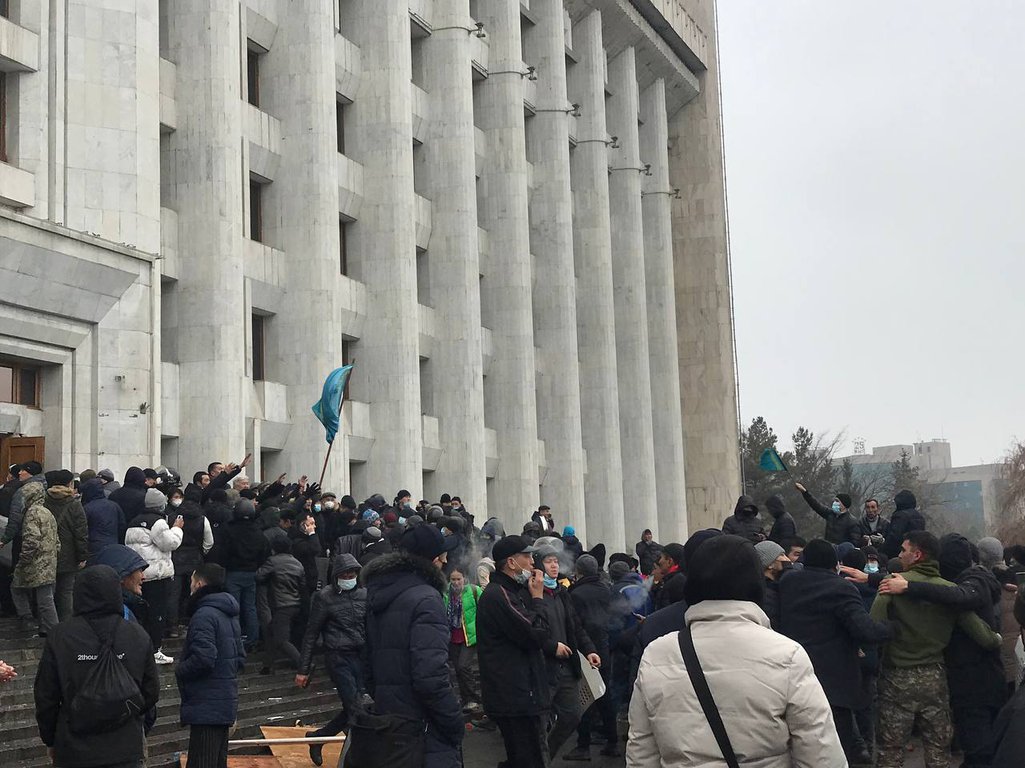
Gradually, the procession reached Republic Square, which was already occupied by other protesters. Firecrackers, flash-noise grenades and tear gas flew from the city administration. Several groups of men broke the windows and doors and went inside.
At this point, wounded demonstrators began to emerge and were carried away from the firing. Someone spoke about the death of several people. Some of those in the square were sure that when you got close to the security forces, they would shoot live ammunition. Others claimed they were shooting rubber bullets. A thick fog covered the neighbouring streets more and more.
In the evening, barricades began to appear near the city administration. This was probably the moment when the protest turned into an armed riot. Eyewitnesses began to report that gun shops had been looted and police stations had been attacked. People with firearms began to dominate over peaceful protesters on the streets. The first reports of those killed were received at this time, but it was impossible to verify them: no one answered calls at the city police department.
The approaches to the presidential residence in Almaty, meanwhile, were overflowing with young men. The fire in the city administration was growing. Soon, more fires were blazing in the buildings of state TV channels located opposite the city administration. It seemed as if the whole area was drowning in flames.
From protests to armed riots
A little later, it was reported that the city prosecutor’s office had been set on fire. At night, unidentified persons tried to seize various important buildings, including hospitals and Almaty city airport. An attack also took place at the city police station. The number of armed people near government administrative buildings began to grow.
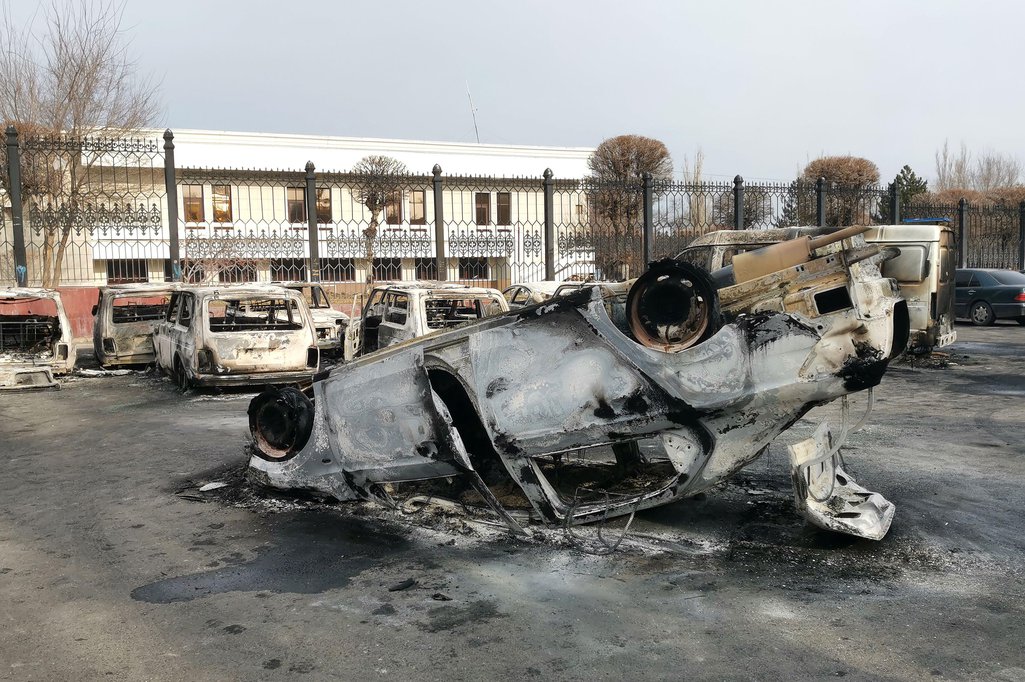
It is not known exactly who made up these armed groups. But in Almaty, according to the Ministry of Internal Affairs, extremists, criminal groups and looters were operating. It is also unknown who coordinated them – and on what conditions – or whether they were connected with one another. The ministry is now conducting an investigation to establish these facts.
Photos and videos of people ransacking shopping boutiques, restaurants and banks flooded Kazakhstani social media. There were fewer and fewer police and military personnel visible. Eyewitnesses noticed that almost no one opposed the looters.
On 10 January, president Kassym-Zhomart Tokayev said that the armed riots had caused $2-3bn in damage to Kazakhstan’s economy. Similar riots swept through many other parts of Kazakhstan. Active opposition to the violence emerged in several other regions: Zhambyl, Kyzylorda and Almaty.
In Taraz, a city in southern Kazakhstan, a branch of the Nur Otan party burned down completely. Three police buildings and the regional administration were also burned down. In the city of Aktobe in western Kazakhstan, three floors of the regional administration building were destroyed. In Taldykorgan, not far from Almaty, an unidentified armed group tried to seize the town’s prison, but failed.
Against intervention
On the night of 6 January, the state of emergency was extended to the whole of Kazakhstan. In parallel, Tokayev appealed to the heads of state of the Russian-backed Collective Security Treaty Organisation (CSTO) with a request to send troops to Kazakhstan. The presidents of Russia and Belarus were the first to respond. Soon they were joined by troops from Armenia, Tajikistan and Kyrgyzstan.
Foreign military forces were sent for a limited period of time to protect Kazakhstani government facilities. Many citizens perceived this as a threat to Kazakhstan’s sovereignty and a possible reason for conflict between the country’s two large ethnic groups – Kazakhs and Russians.
This fear was justified. Despite an upsurge in violence in Almaty and several other regions, rallies in other parts of Kazakhstan continued to be peaceful until 8 January. On 6 and 7 January, thousands of people – men and women of all different ages – remained in the central squares of towns and cities. They feared that the CSTO units would begin to use unreasonable force against them. This could be due to the recent, unfounded scandal over the alleged oppression of ethnic Russians in Kazakhstan.
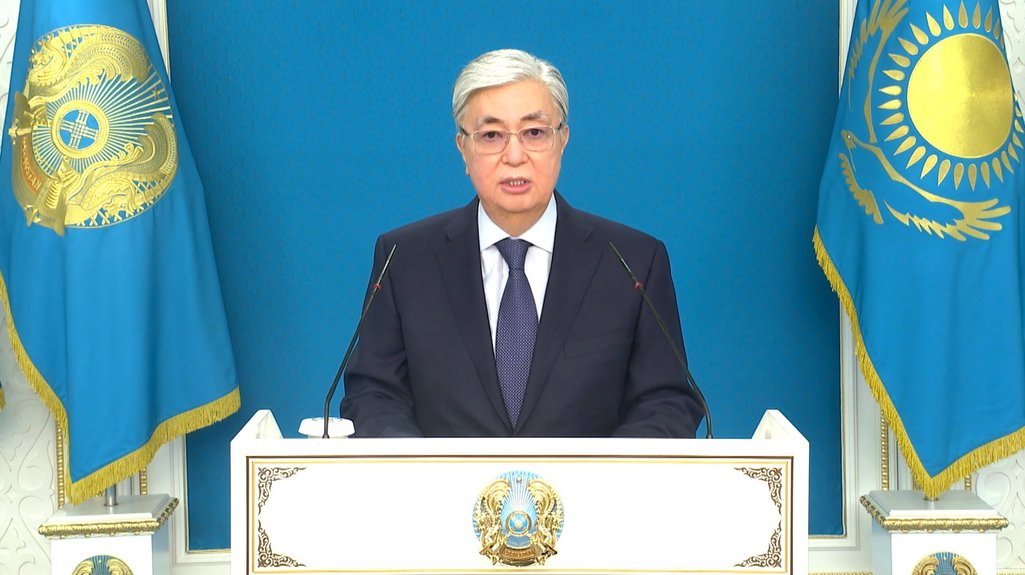
In contrast, overnight on 7 January, President Tokayev categorically stated that Kazakhstan had been attacked by ‘terrorists’, and pro-government experts began to echo him. Allegedly, without the CSTO troops, Almaty would have turned into an Islamic caliphate, they claimed. Mass executions and rape of women would have begun in the city. At the same time, no one tried to give an answer as to why Kazakhstan, which has more than 70,000 people in its armed forces, was not capable of repelling 20,000 so-called ‘terrorists and bandits’.
Neither the experts, nor the president, nor the security forces explained what exactly made the armed groups ‘terrorists’. After security forces began to detain people, religious literature was found in some of their personal belongings – so far, this is all that has been presented as evidence. Why this literature was called ‘extremist’ before a forensic examination, no one could say.
This deliberately vague use of the term ‘extremist’ creates a dangerous interpretation. Peaceful demonstrators, journalists and human rights activists can easily be classed as ‘terrorists’. After Tokayev’s speech, many of these people expressed concern on social media that the ‘anti-terrorist operation’ would end in repression against them.
In the afternoon of 6 January, activists began to flock to Almaty’s city administration building. Somewere cleaning up the mess, and others joined them, holding banners reading ‘Tokayev, withdraw troops (CSTO), we are a peaceful people’ and ‘We are residents of Almaty, we are not terrorists’. Hours later, at least one of these protesters was shot.
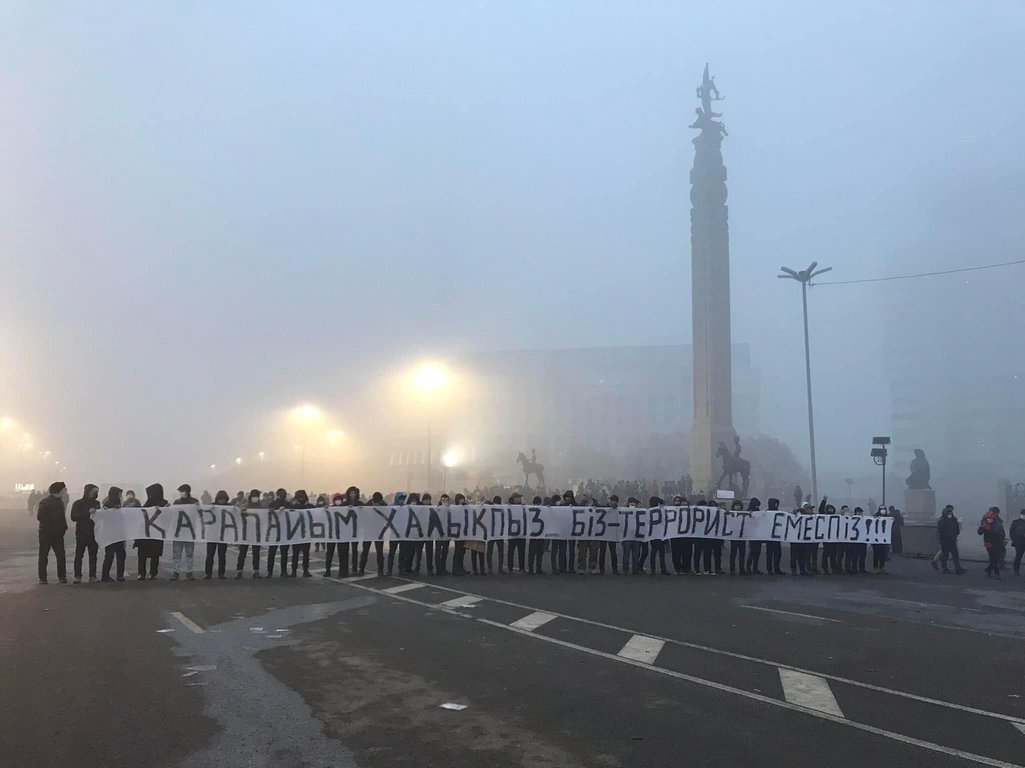
Identifying the culprit
On 7 January, President Tokayev and his subordinates proposed a more detailed categorisation of protest participants. In addition to peaceful protesters, supporters of radical religious movements, criminal groups and looters were singled out.
The official charges of armed riots were brought against radical religious movements and criminals. Viewers of state TV channels were broadcast videos in which detainees admitted that they were foreigners and had come to Kazakhstan to organise riots for money.
One of the detainees was a citizen of Kyrgyzstan, jazz musician Vikram Ruzakhunov. In a video taken in custody, Ruzakhunov said that he was allegedly paid a little more than $200 for participating in the violence. After being released from custody, he explained that he had given the testimony only to ensure he was deported to Kyrgyzstan. If not for the efforts of civil society and the Ministry of Internal Affairs of Kyrgyzstan, Ruzakhunov could have faced a prison term. Another 38 citizens of Kyrgyzstan were detained as part of investigations, but were soon released.

At the same time, experts argued that Kazakhstan was not under attack from terrorists, but rather a clash between two political clans. Arguments appeared in the press that Samat Abish, the first deputy chairman of the National Security Committee (KNB), and businessman Kairat Satybaldy were behind the riots. Both are relatives of former President Nazarbayev.
But on 6 January, the head of the KNB, Karim Massimov, was detained on suspicion of high treason, instead of Abish and Satybalda. Several of Massimov’s deputies were also removed from their posts. On 10 January, several senior KNB employees and local police officers were found dead at their homes and workplaces.
On 11 January, Tokayev accused the KNB of ‘ignoring the terrorist threat’. As will be established by law enforcement agencies, some regional KNB leaders voluntarily surrendered their offices to attackers. At least one police chief, in the city of Taraz, was suspected of the same offence. According to so far unconfirmed information, he took his own life while awaiting charges of treason.
Forget about people
From 6-10 January, firefights between security forces and unidentified armed units – whom the state called ‘organised terrorist forces’ – continued in Almaty. At first, the battle covered five or six districts of the city, though it was later pushed to the periphery. Throughout Almaty, there was no access to the internet. There were problems accessing food and utilities. ATMs were disabled or destroyed. Residents were horrified by the lack of information and the incessant shooting.
Most people did not leave their homes, though some ventured to join the squads collecting rubbish and rebuilding the city’s infrastructure. Others, mainly in villages near Almaty, created patrols of local residents to stop looting by strangers who flooded the streets.
People who needed to move from one area of the city to another were in danger all the time. Armed groups also attacked them. The son of Eldar Tuimebayev, the rector of the Kazakhstan National University, died as a result of gunshot wounds, as did two children. It is unclear who committed the shootings.
According to official information, 227 people died during the clashes, including 19 law enforcement personnel. More than 4,500 people were injured, the prosecutor’s office claimed.
By the morning of 11 January, nearly 10,000 people had been detained. But since the Ministry of Internal Affairs does not always specify whether people had weapons or valuables at the time of their arrest, it is unknown how many of those people were detained without good reason. On 17 January, it was reported that 8,354 administrative cases were under investigation, and 819 criminal investigations were active. Of these, 45 cases concerned acts of terrorism, 36 – mass unrest and 15 – murder.
With the restoration of internet access on 10 January, arrests of activists and journalists came to light. The majority were released or sent to administrative detention for a number of days. At least four journalists in the Aktobe region were summoned for interrogation. Human rights activists do not exclude that there may be more arrests and interrogations.
Despite the numerous civilian casualties, the government has paid most attention to the deaths of 19 law enforcement officers. The president has delivered eulogies to the brave police officers and their families are promised free apartments and financial assistance. Ordinary people, meanwhile, receive more pro-forma condolences.
The president’s promises to prevent future outbreaks of protests look no less pro forma, so far. Tokayev vowed to revise the country’s social policy, create a new public fund that will sponsor social protection initiatives, and strengthen the law enforcement system. It looks as if the elites have been told to pay some costs towards the country’s disenfranchised population. In turn, the people are meant to obey the authorities in exchange for a higher salary.
The political order built by Nazarbayev looks so far unscathed. The demands and values of the people have always seemed insignificant compared to the interests of Kazakhstan’s elites. When Tokayev requested troops from the CSTO, he intended to protect the authorities. As he said: “the state will not fall” – and as the Nazarbayev side added: “it is monolithic”.
Despite the destruction of the monument to Nazarbayev in Taldykorgan and broken signs on streets named after him, Tokayev continues to echo the former president. Unpopular initiatives come not from him, but from third parties – Nazarbayev’s favourite trick. Parliamentarians are far from stopping the ritual display of loyalty. And pro-government experts, speaking of the need to abandon the cult of the boss, still praise Nazarbayev’s ‘strong hand’.
Experts predict that next time the cost of not meeting Kazakhstani society’s needs may be too high for the country if the right lessons are not drawn. If we rely too much on one person – Tokayev, who repeats many of Nazarbayev’s actions – and not on our own political participation, then society will be quite capable of making another mistake.
Original source of article: openDemocracy